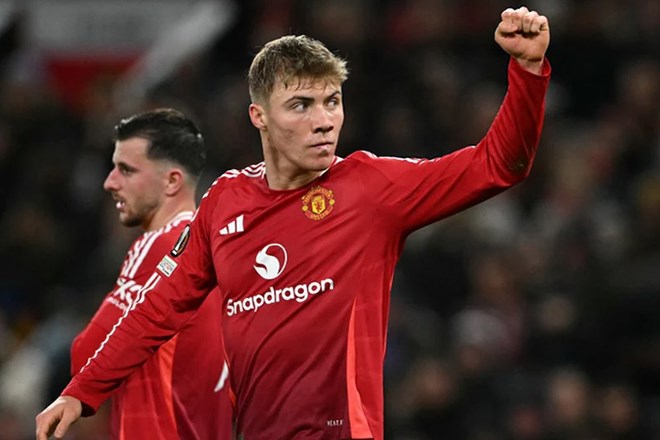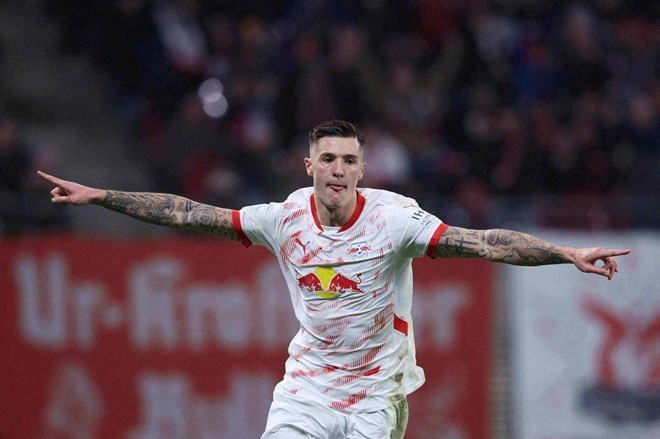After a big break in the 2024-2025 season without really determined to pursue any of the many names associated with him, Manchester United finally got the one they needed.
Benjamin Sesko - a highly rated Slovene striker - arrived at Old Trafford last week after RB Leipzig agreed to sell him for an initial fee of £66 million.
Sesko is the name that Man United have pursued since he was a teenager. Therefore, it is not surprising that the "Red Devils" have a detailed profile of his suitability - both in terms of expertise and personality for the main striker role.
Previously, Man United had hoped Rasmus Hojlund would become the long-term spearhead of the attack when they spent £62 million to bring him back 2 years ago. However, the Danish striker could not maintain his progress after a promising first season, scoring only 4 goals in the Premier League last season.

Hojlund's problem is not just his scoring performance. His physical strength and ability to compete are also questioned.
Among the strikers who played over 900 minutes in the Premier League last season, none have a lower duels winning rate than him (29.5%). Of which, the success rate of 24.6% in air combat missions is the main reason for this decline.
There is also an argument that Hojlund's effectiveness in the box is not high. The Danish striker only had an average of 1.2 shots in the box per 90 minutes - the lowest among the strikers who played more than 900 minutes last season.
The Danish striker may complain about the quality of his passes. And that is probably true to a certain extent.
However, to be fair with his teammates, Hojlund's free-kick moves into the box were targeted by a 38.2% pass. This is the fourth highest number of 33 central strikers who have made at least 200 runs without the ball.
It is worth mentioning that Hojlund's ballless movement rate into the penalty area (26.9%) is still lower than the average of 28.7% of the above-mentioned group of strikers. This shows that Hojlund can be more decisive and "incubator" in moving to create opportunities for himself.
Of course, there is no guarantee that Sesko will be superior, but the general feeling is that he is like a rough diamond with huge potential. His physique and skills make Sesko a complete centre-forward.
Notably, Sesko's duels winning rate (44.4%) in the last two domestic seasons, in addition to the 57.1% air win rate (less than a striker in this statistic), all outperform Hojlund's 33.4%.
However, Sesko may not be the best striker in the box. In fact, his xG (excluding penalties) for each shot in the last two seasons - 0.15 in 2024-2025 and 0.17 in 2023-2024 - are both lower than Hojlund (0.20 and 0.22).
This shows that the Slovene striker still has many aspects to improve in the striker position.
However, Sesko's finishing frequency is superior. He averaged 2.8 shots per 90 minutes last season and 3.0 shots last season, while Hojlund had just 1.6 and 1.7 shots.

Part of the reason is Sesko's preference to work widely, willing to try luck from many positions. Since the start of the 2023-2024 season in all competitions, he has had 41 shots from outside the box - nearly four more than Hojlund's 12 shots, despite playing about 1,100 minutes less in the same period.
Sesko's achievements are also affected by the fact that he mainly plays as a striker in the RB Leipzig attack system. At Man United, the Slovenia striker is likely to carry the attack alone, with the support of Matheus Cunha and Bryan Mbeumo.
No one is sure Hojlund will not explode in a similar system. In any case, the truth is that Man United are finally capable of solving the problem of scoring.
The remaining question is whether these changes are enough to cover up other weaknesses, but Amorim has clearly received maximum support.
And so, a new chapter in Man United's rebirth journey began...










